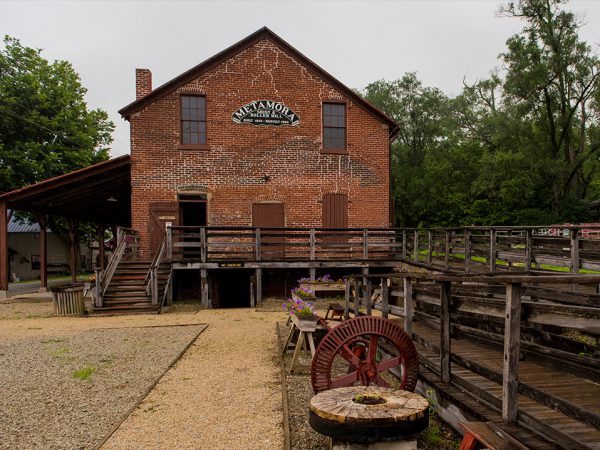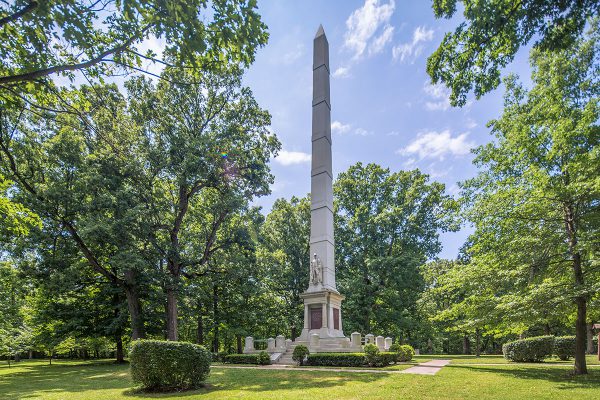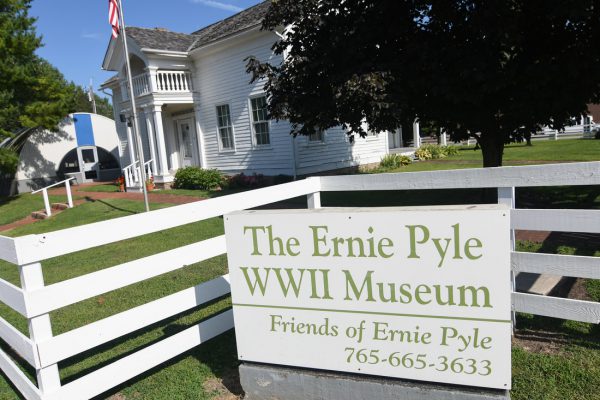Indiana's story stretches well into history, with significant events happening well before statehood was granted in 1816, and visitors can experience the people and places of the past firsthand at historic sites across the state. You are guaranteed to find a new favorite at these 20 historic sites in Indiana.
This list was part of The 20 IN 20. Even though 2020 is behind us, you still have to see our 400 must-see, must-do Indiana experiences! Find images shared by visitors and the full historic sites list below!
Benjamin Harrison Presidential Site, Indianapolis
Benjamin Harrison, the 23rd President of the United States, is one of the most prestigious Hoosiers in history. He and his wife began construction of a 16-room Italianate style house in Indianapolis in 1868. The Harrison's chose everything in the house, from the layout inside to the red brick on the exterior. The house served as a prominent campaign spot during his as his 1888 campaign and was his permanent home until his death in 1901. You can now visit and explore artifacts, photographs, documents, furniture, and more related to Benjamin Harrison's story! Learn more.
Corydon Capitol State Historic Site, Corydon
Here, you can relive Indiana's transformation from a territorial outpost to a modern state. As Indiana's first state capitol, Corydon is rich in history. A tour at the original state Capitol building which served as Indiana's government center in the early 1800's will take you back in time. Also, the first state constitution is believed to have been drafted under the branches of Constitution Elm!
Culbertson Mansion State Historic Site, New Albany
After moving to Indiana in the middle of the 20th century, William Culbertsonbecame one of the richest and most philanthropic men in Indiana. His incredible 20,000-square foot mansion boasts hand-painted ceilings, a remarkable carved staircase, and other intricate masterworks. Guided tours at the mansion last about one hour while visitors are entrenched in Victorian culture. You can even play take part in real life CLUE during the holidays! Learn more.
Limberlost State Historic Site, Geneva
Gene Stratton-Porter fell in love with nature while growing up in Indiana. She and her family decided to build a large home near the Limberlost Swamp in 1887. While living in the "Limberlost Cabin", Gene documented nature and eventually became a prominent fictional writer, at her peak reaching an estimated 50 million readers. Of her twelve novels, seven are dedicated to nature and eight were adapted into moving pictures. The Limberlost home and greenhouse are open to the public for tours! Learn more.
Lincoln Boyhood National Memorial, Lincoln City
"There I Grew Up..." Abraham Lincoln, the 16th President of the United States and one of the most influential people in American history, spent 14 of his formative childhood years in Indiana. The National Memorial offers a glimpse into the young pioneer life of the future president. A quaint hike through the woods will take you to the Cabin Site Memorial and the gravesite of Lincoln's mother, Nancy Hanks Lincoln. Learn More.
Wilbur Wright Birthplace & Museum, Hagerstown
Wilbur Wright, one-half of the famous Wright brothers, was born in a small farmhouse in eastern Henry County. Wilbur and his brother Orville designed, built and tested the world's first successful airplane. The Wilbur Wright Birthplace & Museum honors his legacy and allows visors to learn more about the beginnings of aviation. Tours are offered at the site. Learn more.
George Rogers Clark National Historical Park, Vincennes
Colonel George Rogers Clark and his army captured the British Fort Sackville in 1779 in one of the greatest feats of the Revolutionary War. Aided by French residents, the capture of Fort Sackville allowed the United States claim to the frontier. The George Rogers Clark Clark National Historical Park is home to the largest national monument outside of Washington, D.C. Learn More.
Whitewater Canal State Historic Site & Whitewater Valley Railroad, Metamora
When the Whitewater Canal was built in the 1800s, the engineering miracle turned Indiana into the "Crossroads of America" by forming natural trade routes. After floods and droughts damaged the canal, the White Water Valley Railroad was built. You can experience the history of both in Metamora. Thirty-minute boat tours of the canal are offered on the Ben Franklin III. Pulled by two Belgian Draft horses, it is an experience like no other. Train rides on the Whitewater Valley Railroad are given from April through December.
Gene Stratton-Porter State Historic Site, Rome City
After Gene Stratton-Porter was saddened by the draining of the Limberlost Swamp, she decided to build the "Cabin at Wildlife Woods" in 1914. With over 148 acres of prairies, gardens, woods, lakes, and wetlands, Gene fell in love with the property on Sylvan Lake. The Carriage House Visitor Center gives visitors the opportunity to learn all about nature topics like moths, wildflowers, woodpeckers, and more. The gravesites of Gene and her daughter are located on-site. Learn more.
Vincennes State Historic Site, Vincennes
At the Vincennes State Historic Site, you will take a step back in time and see where Indiana's foundations were formed. Founded in 1732, Vincennes is Indiana's oldest city. As Indiana's territorial capitol before it officially became a state, territory officials made decisions that changed the course of history. Tours of the territorial capitol building are offered. Learn more.
Tippecanoe Battlefield Memorial, West Lafayette
The 96-acre park commemorates the 1811 Battle of Tippecanoe. American forces led by future President of the United States William Henry Harrison fought the Native American Confederation led by Tecumseh. An 85-foot marble monument, erected in 1908, stands to pay tribute to the battle. The Tippecanoe Battlefield museum tells the story of the battle and puts the fight into geopolitical context.
Falls of the Ohio State Park and Lewis & Clark Trail, Clarksville
During the summer of 1803, William Clark received a letter from Meriweather Lewis asking him come along on an expedition to the Louisiana Territory. Lewis and Clark met at Falls of the Ohio later that year to begin their incredible journey out west. Their meeting is honored at Falls of the Ohio State Park, which is also home to some of the oldest fossil beds in the entire world.
Wabash & Erie Canal Park, Delphi
The Wabash & Erie Canal connected the Great Lakes to the Ohio Rivers and opened up trade throughout the region. With a pioneer village, interpretative museum, and functioning canal boat ride, a visit to to the Wabash & Erie Canal Park is like stepping back time.
Angel Mounds State Historic Site, Evansville
The heritage at the Angel Mounds State Historic Site stretches back about 1,000 years. Around 1000 AD, a group of Native Americans began building a town along the Ohio River. The land was chosen because the river offered protection with the river on one side and a slough on the opposing side. The community built large platform mounds, defensive palisades, and numerous dwellings. Angel Mounds is a great example of the Mississippian Culture.
Levi & Catharine Coffin State Historic Site, Fountain City
Levi and Catharine Coffin of Newport (now known as Fountain City) were two important abolitionist leaders that played a significant role in the Underground Railroad. As conductors, they helped more than 1,000 slaves reach freedom safely. You can now take a guided tour of the house that protected the freedom seekers!
T.C. Steele State Historic Site, Nashville
American painter T.C. Steele moved to Brown County in 1907 with his wife to establish a home and studio. The rolling hills, beautiful landscape, and unmatched nature inspired many of his noted artworks. A collection of Steele's artwork are displayed in his home, which he referred to as the "House of the Singing Winds". The nearly unchanged property boasts a beautiful garden and multiple hiking trails.
Monastery of the Immaculate Conception, Ferdinand
The Monastery of Immaculate Conception was founded in 1867 and is home to one of the nation's largest groups of Benedictine women. The one-of-a-kind 87 foot Romanesque dome makes the nickname "Castle on the Hill" fit perfectly. Grandeur design throughout the church is just one of the reasons it is listed on the National Register of Historic Places.
New Harmony State Historic Site, New Harmony
The Harmony Society decided to establish the Utopian town of New Harmony in 1814. Harmonists, as they were known, originated from Germany and tried to reach Christian perfection in every aspect of their life. After the town was sold 11 years later, two businessmen wanted to turn New Harmony into a place where education and social equality would be paramount. Scientists, scholars, and more moved there in hopes of living in a Utopian society. Guided tours are offered and begin at the Atheneum/Visitors Center.
Grouseland - William Henry Harrison Mansion & Museum, Vincennes
Grouseland is the elegant home built in 1804 for William Henry Harrison when he was Governor of the Indiana Territory. It is the first brick home in Indiana and is a National Historic Landmark. That being said, Grouseland was more than just a home as it was the center of the Indiana Government for years. William Henry Harrison was elected President of United States in 1841 but died 31 days into his term after he contracted paratyphoid fever.
The Ernie Pyle WWII Museum, Dana
Ernie Pyle was born in Dana, IN in 1900. He worked as a journalist early in his career when WWII prompted him to become a war correspondent. Articles he penned described what it was like to be a solider and the struggles they faced. On site, you will find Ernie Pyle's birthplace along with a museum that showcases his life as a journalist and writings during WWII.
Plan your #The20IN20 trip by checking out the map of historic sites below!





















